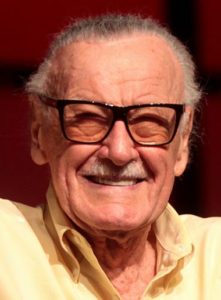The King of Comics

Jack Kirby (Credit: Susan Skaar)
Jacob Kurtzberg (1917-1994) was born in Manhattan to poor Jewish immigrants from Austria. He loved to draw as a child, and taught himself art techniques by studying comic strips and political cartoons in newspapers. He was rejected by the Alliance Art School (a branch of the Educational Alliance in Manhattan that was created by wealthy Jews to assist and integrate poor Eastern European Jewish immigrants), and quit Brooklyn’s Pratt Institute after a week. At 19, he started working on newspaper comic strips, first under the pseudonym Jack Curtiss. For a time he worked on Popeye cartoons, then switched to comic books. He worked on many productions over the next few years, and published under a variety of pen names, finally settling on Jack Kirby. Soon, Kirby teamed up with Joe Simon, and the two were hired by Timely Comics, later renamed Marvel Comics. Simon and Kirby’s first creation was Captain America. The comic was a huge success, but Marvel didn’t pay a good wage so they moved over to DC Comics. There, they produced a number of hits, selling over a million copies each month. During World War II, Kirby was drafted to the army and fought in Normandy. In the winter, he had severe frostbite and military doctors nearly amputated both of his legs. He was able to recover, and was awarded a number of medals, including the Bronze Star. Returning to America after the war, Kirby reunited with Simon and the two worked on a number of projects, including a stretch making popular romance comics that sold several million copies a month. At one point, they ran their own comics company. Eventually, the partnership soured and the two parted ways. Kirby eventually returned to Marvel. Partnering with Stan Lee, the two went on to revolutionize comics and usher in its “Silver Age”. Their first creation was the Fantastic Four, followed by more famous figures like the Hulk, Thor, Iron Man, Galactus, Silver Surfer, Black Panther, and the X-Men. In 1963, they combined some of these heroes to create The Avengers. Many of these characters have since been adapted to the big screen, making the Marvel Cinematic Universe the highest-grossing film franchise of all time. (The latest – and for now, final – installment of The Avengers, Endgame, opens this week and is expected to break nearly all movie records.) Kirby has been credited with being “the single most influential figure in the turnaround in Marvel’s fortunes from the time he rejoined the company.” He helped make comic book characters and their stories deeper and richer, more vibrant and alive, and more meaningful for readers young and old. Kirby also pioneered a number of new art techniques, including his famous “Kirby Krackle” energy fields. In 1970, he moved back to work for DC Comics, then came back to Marvel in 1976. During this time, he created The Eternals (rumoured to be the next big Marvel film series). Through the 1980s and until his last days, Kirby continued to create characters and draw comics. He was involved in a number of cartoons and film animations, too. Kirby felt like he never got the credit he deserved, and spent a great deal of time fighting for the rights to his own work. At the end, he only got about 2000 pages of the 13,000 pages he drew for Marvel alone. Nonetheless, the impact he had on the comic books industry, and on the world of art and film in general is immeasurable. Many artists, writers, and filmmakers point to him as their main inspiration. Kirby has been called “the King of Comics” and “one of the chief architects of the American imagination.”
How the “Splitting of the Sea” Can Change Your Life
Words of the Week
The best way to find yourself is to lose yourself in the service of others.
– Gandhi

The first issue of The Avengers (September 1963); cover of Fantastic Four #72 (March 1968), showing characteristic “Kirby Krackles” in the background; a page from Fantastic Four #61 (June 1966) illustrated by Jack Kirby.



